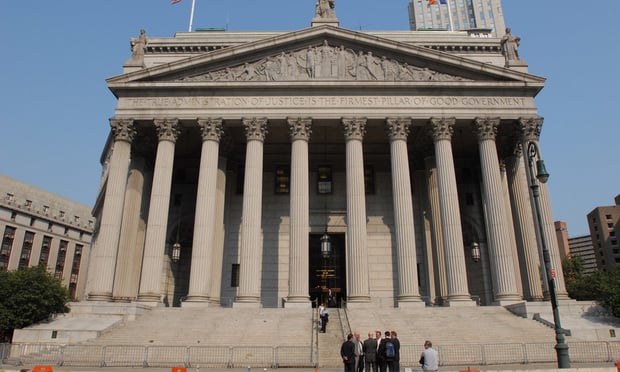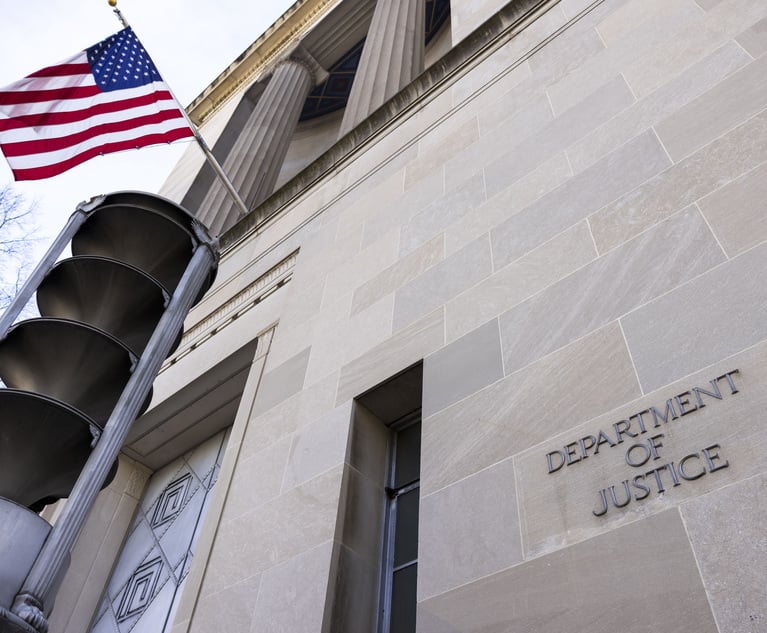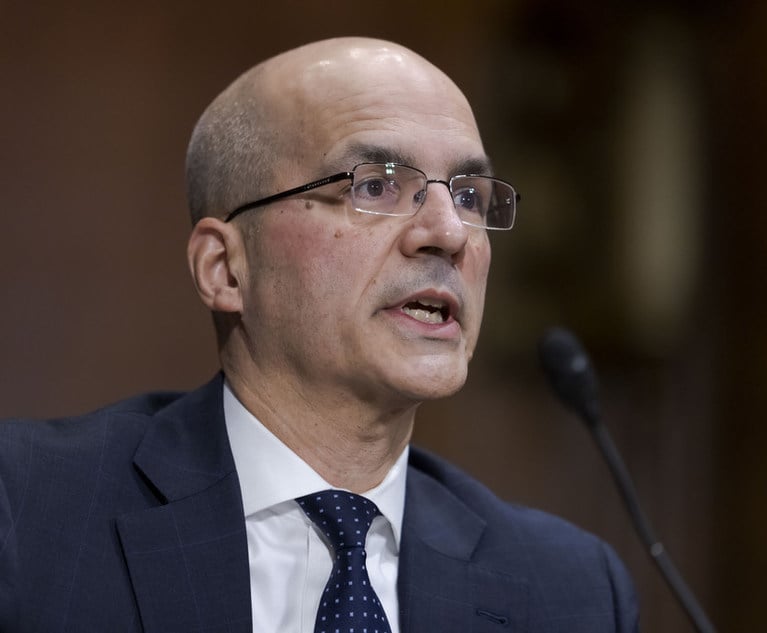Avoiding the Trap: Navigating the Commercial Division's Expert Disclosure Rules
Practice in the Commercial Division often differs quite significantly from elsewhere in the state court system. One of these differences involves rules for expert disclosure, which are now arguably just as robust in the Commercial Division as in federal court. This, however, may have opened up a trap for the unwary: “Expert” disclosures may be required with respect to witnesses who appear to be fact witnesses if their testimony is based in part on some kind of expert knowledge.
February 21, 2019 at 02:35 PM
6 minute read
 New York Supreme Court, Commercial Division, at 60 Centre Street
New York Supreme Court, Commercial Division, at 60 Centre Street
The rules of the Commercial Division of New York's Supreme Court have evolved over time to look more and more like those of federal court. As a result, practice in the Commercial Division often differs quite significantly from elsewhere in the state court system. One of these differences involves rules for expert disclosure, which are now arguably just as robust in the Commercial Division as in federal court. This, however, may have opened up a trap for the unwary: “Expert” disclosures may be required with respect to witnesses who appear to be fact witnesses if their testimony is based in part on some kind of expert knowledge. One federal judge has aptly referred to this as “embedded expert testimony.” See U.S. v. Orr, 692 F.3d 1079, 1102 (10th Cir. 2012) (Holloway, J. dissenting in part). And here lies the trap: In federal court, failure to properly disclose such testimony can lead to preclusion. See, e.g., Point 4 Data v. Tri State Surgical Supply Equip't Ltd., 2013 WL 5502852 (E.D.N.Y. Oct. 1, 2013) (precluding testimony of party witnesses concerning industry norms and technical aspects of certain software, on the ground that it was not properly disclosed as expert testimony).
There is a reason why this is now tricky territory. Although the Commercial Division Rules appear to diverge from the federal rules on this issue, the difference may be superficial. Commercial Division Rule 13(c)—which took effect in 2013—mirrors Fed. R. Civ. P. 26(a)(2) in requiring that expert disclosure must be “accompanied by a written report, prepared and signed by the witness, if either (1) the witness is retained or specially employed to give expert witness testimony in the case, or (2) the witness is a party's employee whose duties regularly involve giving expert testimony.” Like Fed. R. Civ. P. 26(a)(2), Rule 13(c) specifies the timing and required content of such a report, which must contain a “complete statement of all opinions the witness will express and the basis and the reasons for them” (emphasis added). This “complete statement” requires substantially more detail than the parallel provisions of New York's Civil Practice Law and Rules (CPLR), which apply generally in New York Supreme Court and mandate only disclosure “in reasonable detail” of the “subject matter” of the expert's testimony, the “substance” of the expert' opinion, and a “summary of the grounds” for that opinion. See CPLR 3101(d)(1)(i). When this change was made to the Commercial Division Rules—which apply in the Commercial Division as an overlay to the CPLR—the clear intent was to bring Commercial Division practice closer to federal court practice.
Fed. R. Civ. P. 26(a)(2), however, contains an additional provision that is absent from Commercial Division Rule 13(c). Under the federal rule, although a fact witness whose testimony may include opinions or conclusions based on scientific, technical, or other specialized knowledge need not produce an expert report, the party proffering such testimony must make an expert disclosure that states (1) “the subject matter on which the witness is expected to present [such] evidence”; and (2) “a summary of the facts and opinions to which the witness is expected to testify.” Fed. R. Civ. P. 26(a)(2)(C). A fact witness whose testimony contains such “embedded” expert testimony is subject to exclusion if that testimony is not sufficiently disclosed—as in Point 4 Data, supra.
Commercial Division Rule 13(c) does not on its face require specific disclosures with respect to such embedded testimony, but that does not mean the issue is of no concern. The disclosure requirements of Fed. R. Civ. P. 26(a)(2)(C) for embedded expert testimony are materially nearly identical to those set forth in CPLR 3101(d)(1)(i). Because Commercial Division Rule 13(c) expressly requires expert disclosure be “accompanied” by a written report, prepared and signed by the witness, “if” the witness falls into one of two categories, it leaves open the possibility that expert disclosure might also have to include certain kinds of information about witnesses who are not in those two categories. In some instances, such witnesses might be subject to the more general (and less detailed) disclosure requirements of CPLR 3101(d)(1)(i)—just as, in federal court, they are subject to the parallel requirements of Fed. R. Civ. P. 26(a)(2)(C).
Harris v. Campbell, 155 A.D.3d 1622 (4th Dept. 2017), suggests as much. There, the plaintiff offered the testimony of a treating physician—a kind of witness that generally does not have to provide expert disclosures under CPLR 3101(d)(1) because such a physician's records and reports are fully disclosed (and his or her deposition is taken) through other discovery mechanisms. 155 A.D.3d at 1622. The physician, however, had also “received a Ph.D. in biomechanical engineering,” and testified that he “often relie[d] on his engineering background in his medical practice.” Id. at 1622-23. In affirming the lower court's judgment entered upon a jury verdict in favor of the defendant, the court held that the physician's proffered testimony “about the amount of force needed to cause” the plaintiff's injury was properly precluded as expert testimony that was not sufficiently disclosed. Id. at 1623.
Harris was not a Commercial Division case. But it may provide a cautionary tale. Parties in the Commercial Division do at times object to failures to make appropriate disclosures concerning “expert” analyses embedded in the testimony of fact witnesses. See, e.g., Singh v. PGA Tour, 2017 WL 2152584, *15-16 (Sup. Ct. N.Y. Co. May 17, 2017) (rejecting such an argument on the ground that the proffered testimony was of a type that had specifically been held to be non-expert testimony in the relevant case law). Moreover, courts within the Commercial Division occasionally look to cases decided under Fed. R. Civ. P. 26(a)(2) for guidance when applying Commercial Division Rule 13(c). See id. Those courts may be receptive to preclusion arguments concerning embedded expert testimony if the circumstances suggest that a proffering party “hid the ball” in a way that the federal courts would not tolerate.
There is, however, no reason for anyone to have to wonder how to address embedded expert testimony. Commercial Division Rule 13(c)—like many of the Commercial Division Rules—begins with a requirement that the parties “confer” on the scope and timing of expert disclosure (and that they involve the court if they cannot reach an agreement themselves). In so doing, the parties can address the question of whether CPLR 3101(d)(1)(i) disclosures will be required of any fact witness whose testimony might include embedded expert opinions. The parties, in other words, can chart their own course in this regard. To avoid misunderstandings (or worse) both sides in every case before the Commercial Division should consider embedded expert testimony in charting that course.
Adrienne B. Koch is a litigation partner with Katsky Korins in New York.
This content has been archived. It is available through our partners, LexisNexis® and Bloomberg Law.
To view this content, please continue to their sites.
Not a Lexis Subscriber?
Subscribe Now
Not a Bloomberg Law Subscriber?
Subscribe Now
NOT FOR REPRINT
© 2025 ALM Global, LLC, All Rights Reserved. Request academic re-use from www.copyright.com. All other uses, submit a request to [email protected]. For more information visit Asset & Logo Licensing.
You Might Like
View All
'A Shock to the System’: Some Government Attorneys Are Forced Out, While Others Weigh Job Options
7 minute read
'Serious Legal Errors'?: Rival League May Appeal Following Dismissal of Soccer Antitrust Case
6 minute read
How Some Elite Law Firms Are Growing Equity Partner Ranks Faster Than Others
4 minute read
Trending Stories
- 1ACC CLO Survey Waves Warning Flags for Boards
- 2States Accuse Trump of Thwarting Court's Funding Restoration Order
- 3Microsoft Becomes Latest Tech Company to Face Claims of Stealing Marketing Commissions From Influencers
- 4Coral Gables Attorney Busted for Stalking Lawyer
- 5Trump's DOJ Delays Releasing Jan. 6 FBI Agents List Under Consent Order
Who Got The Work
J. Brugh Lower of Gibbons has entered an appearance for industrial equipment supplier Devco Corporation in a pending trademark infringement lawsuit. The suit, accusing the defendant of selling knock-off Graco products, was filed Dec. 18 in New Jersey District Court by Rivkin Radler on behalf of Graco Inc. and Graco Minnesota. The case, assigned to U.S. District Judge Zahid N. Quraishi, is 3:24-cv-11294, Graco Inc. et al v. Devco Corporation.
Who Got The Work
Rebecca Maller-Stein and Kent A. Yalowitz of Arnold & Porter Kaye Scholer have entered their appearances for Hanaco Venture Capital and its executives, Lior Prosor and David Frankel, in a pending securities lawsuit. The action, filed on Dec. 24 in New York Southern District Court by Zell, Aron & Co. on behalf of Goldeneye Advisors, accuses the defendants of negligently and fraudulently managing the plaintiff's $1 million investment. The case, assigned to U.S. District Judge Vernon S. Broderick, is 1:24-cv-09918, Goldeneye Advisors, LLC v. Hanaco Venture Capital, Ltd. et al.
Who Got The Work
Attorneys from A&O Shearman has stepped in as defense counsel for Toronto-Dominion Bank and other defendants in a pending securities class action. The suit, filed Dec. 11 in New York Southern District Court by Bleichmar Fonti & Auld, accuses the defendants of concealing the bank's 'pervasive' deficiencies in regards to its compliance with the Bank Secrecy Act and the quality of its anti-money laundering controls. The case, assigned to U.S. District Judge Arun Subramanian, is 1:24-cv-09445, Gonzalez v. The Toronto-Dominion Bank et al.
Who Got The Work
Crown Castle International, a Pennsylvania company providing shared communications infrastructure, has turned to Luke D. Wolf of Gordon Rees Scully Mansukhani to fend off a pending breach-of-contract lawsuit. The court action, filed Nov. 25 in Michigan Eastern District Court by Hooper Hathaway PC on behalf of The Town Residences LLC, accuses Crown Castle of failing to transfer approximately $30,000 in utility payments from T-Mobile in breach of a roof-top lease and assignment agreement. The case, assigned to U.S. District Judge Susan K. Declercq, is 2:24-cv-13131, The Town Residences LLC v. T-Mobile US, Inc. et al.
Who Got The Work
Wilfred P. Coronato and Daniel M. Schwartz of McCarter & English have stepped in as defense counsel to Electrolux Home Products Inc. in a pending product liability lawsuit. The court action, filed Nov. 26 in New York Eastern District Court by Poulos Lopiccolo PC and Nagel Rice LLP on behalf of David Stern, alleges that the defendant's refrigerators’ drawers and shelving repeatedly break and fall apart within months after purchase. The case, assigned to U.S. District Judge Joan M. Azrack, is 2:24-cv-08204, Stern v. Electrolux Home Products, Inc.
Featured Firms
Law Offices of Gary Martin Hays & Associates, P.C.
(470) 294-1674
Law Offices of Mark E. Salomone
(857) 444-6468
Smith & Hassler
(713) 739-1250






